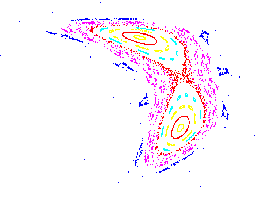Weakly dissipative predator-prey systems

In the presence of seasonal forcing, predator-prey models with quadratic interaction terms and weak dissipation can exhibit infinite numbers of coexisting periodic attractors corresponding to cycles of different magnitude and frequency. These motions are best understood with reference to the conservative case, for which the degree of dissipation is, by definition, zero. Here one observes the familiar mix of “regular” (neutrally stable orbits and tori) and chaotic motion typical of non-integrable Hamiltonian systems. Perturbing away from the conservative limit, the chaos becomes transitory. In addition, the invariant tori are destroyed and the neutrally stable periodic orbits becomes stable limit cycles, the basins of attraction of which are intertwined in a complicated fashion. As a result, stochastic perturbations can bounce the system from one basin to another with consequent changes in system behavior. Biologically, weak dissipation corresponds to the case in which predators are able to regulate the density of their prey well below carrying capacity.
